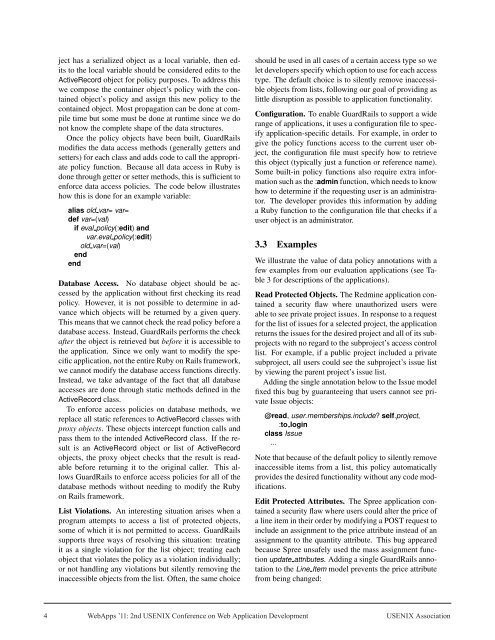2nd USENIX Conference on Web Application Development ...
2nd USENIX Conference on Web Application Development ...
2nd USENIX Conference on Web Application Development ...
You also want an ePaper? Increase the reach of your titles
YUMPU automatically turns print PDFs into web optimized ePapers that Google loves.
ject has a serialized object as a local variable, then edits<br />
to the local variable should be c<strong>on</strong>sidered edits to the<br />
ActiveRecord object for policy purposes. To address this<br />
we compose the c<strong>on</strong>tainer object’s policy with the c<strong>on</strong>tained<br />
object’s policy and assign this new policy to the<br />
c<strong>on</strong>tained object. Most propagati<strong>on</strong> can be d<strong>on</strong>e at compile<br />
time but some must be d<strong>on</strong>e at runtime since we do<br />
not know the complete shape of the data structures.<br />
Once the policy objects have been built, GuardRails<br />
modifies the data access methods (generally getters and<br />
setters) for each class and adds code to call the appropriate<br />
policy functi<strong>on</strong>. Because all data access in Ruby is<br />
d<strong>on</strong>e through getter or setter methods, this is sufficient to<br />
enforce data access policies. The code below illustrates<br />
how this is d<strong>on</strong>e for an example variable:<br />
alias old var= var=<br />
def var=(val)<br />
if eval policy(:edit) and<br />
var.eval policy(:edit)<br />
old var=(val)<br />
end<br />
end<br />
Database Access. No database object should be accessed<br />
by the applicati<strong>on</strong> without first checking its read<br />
policy. However, it is not possible to determine in advance<br />
which objects will be returned by a given query.<br />
This means that we cannot check the read policy before a<br />
database access. Instead, GuardRails performs the check<br />
after the object is retrieved but before it is accessible to<br />
the applicati<strong>on</strong>. Since we <strong>on</strong>ly want to modify the specific<br />
applicati<strong>on</strong>, not the entire Ruby <strong>on</strong> Rails framework,<br />
we cannot modify the database access functi<strong>on</strong>s directly.<br />
Instead, we take advantage of the fact that all database<br />
accesses are d<strong>on</strong>e through static methods defined in the<br />
ActiveRecord class.<br />
To enforce access policies <strong>on</strong> database methods, we<br />
replace all static references to ActiveRecord classes with<br />
proxy objects. These objects intercept functi<strong>on</strong> calls and<br />
pass them to the intended ActiveRecord class. If the result<br />
is an ActiveRecord object or list of ActiveRecord<br />
objects, the proxy object checks that the result is readable<br />
before returning it to the original caller. This allows<br />
GuardRails to enforce access policies for all of the<br />
database methods without needing to modify the Ruby<br />
<strong>on</strong> Rails framework.<br />
List Violati<strong>on</strong>s. An interesting situati<strong>on</strong> arises when a<br />
program attempts to access a list of protected objects,<br />
some of which it is not permitted to access. GuardRails<br />
supports three ways of resolving this situati<strong>on</strong>: treating<br />
it as a single violati<strong>on</strong> for the list object; treating each<br />
object that violates the policy as a violati<strong>on</strong> individually;<br />
or not handling any violati<strong>on</strong>s but silently removing the<br />
inaccessible objects from the list. Often, the same choice<br />
should be used in all cases of a certain access type so we<br />
let developers specify which opti<strong>on</strong> to use for each access<br />
type. The default choice is to silently remove inaccessible<br />
objects from lists, following our goal of providing as<br />
little disrupti<strong>on</strong> as possible to applicati<strong>on</strong> functi<strong>on</strong>ality.<br />
C<strong>on</strong>figurati<strong>on</strong>. To enable GuardRails to support a wide<br />
range of applicati<strong>on</strong>s, it uses a c<strong>on</strong>figurati<strong>on</strong> file to specify<br />
applicati<strong>on</strong>-specific details. For example, in order to<br />
give the policy functi<strong>on</strong>s access to the current user object,<br />
the c<strong>on</strong>figurati<strong>on</strong> file must specify how to retrieve<br />
this object (typically just a functi<strong>on</strong> or reference name).<br />
Some built-in policy functi<strong>on</strong>s also require extra informati<strong>on</strong><br />
such as the :admin functi<strong>on</strong>, which needs to know<br />
how to determine if the requesting user is an administrator.<br />
The developer provides this informati<strong>on</strong> by adding<br />
a Ruby functi<strong>on</strong> to the c<strong>on</strong>figurati<strong>on</strong> file that checks if a<br />
user object is an administrator.<br />
3.3 Examples<br />
We illustrate the value of data policy annotati<strong>on</strong>s with a<br />
few examples from our evaluati<strong>on</strong> applicati<strong>on</strong>s (see Table<br />
3 for descripti<strong>on</strong>s of the applicati<strong>on</strong>s).<br />
Read Protected Objects. The Redmine applicati<strong>on</strong> c<strong>on</strong>tained<br />
a security flaw where unauthorized users were<br />
able to see private project issues. In resp<strong>on</strong>se to a request<br />
for the list of issues for a selected project, the applicati<strong>on</strong><br />
returns the issues for the desired project and all of its subprojects<br />
with no regard to the subproject’s access c<strong>on</strong>trol<br />
list. For example, if a public project included a private<br />
subproject, all users could see the subproject’s issue list<br />
by viewing the parent project’s issue list.<br />
Adding the single annotati<strong>on</strong> below to the Issue model<br />
fixed this bug by guaranteeing that users cannot see private<br />
Issue objects:<br />
@read, user.memberships.include? self.project,<br />
:to login<br />
class Issue<br />
...<br />
Note that because of the default policy to silently remove<br />
inaccessible items from a list, this policy automatically<br />
provides the desired functi<strong>on</strong>ality without any code modificati<strong>on</strong>s.<br />
Edit Protected Attributes. The Spree applicati<strong>on</strong> c<strong>on</strong>tained<br />
a security flaw where users could alter the price of<br />
a line item in their order by modifying a POST request to<br />
include an assignment to the price attribute instead of an<br />
assignment to the quantity attribute. This bug appeared<br />
because Spree unsafely used the mass assignment functi<strong>on</strong><br />
update attributes. Adding a single GuardRails annotati<strong>on</strong><br />
to the Line Item model prevents the price attribute<br />
from being changed:<br />
4 <strong>Web</strong>Apps ’11: <str<strong>on</strong>g>2nd</str<strong>on</strong>g> <str<strong>on</strong>g>USENIX</str<strong>on</strong>g> <str<strong>on</strong>g>C<strong>on</strong>ference</str<strong>on</strong>g> <strong>on</strong> <strong>Web</strong> Applicati<strong>on</strong> <strong>Development</strong> <str<strong>on</strong>g>USENIX</str<strong>on</strong>g> Associati<strong>on</strong>








